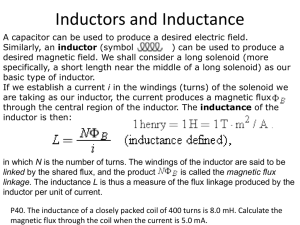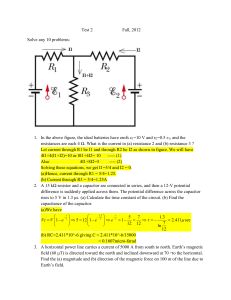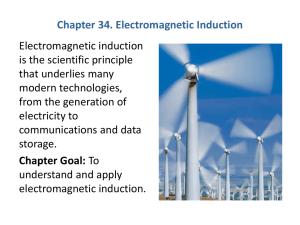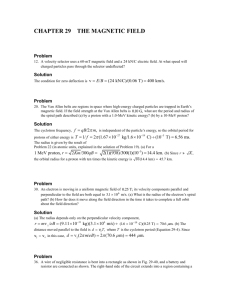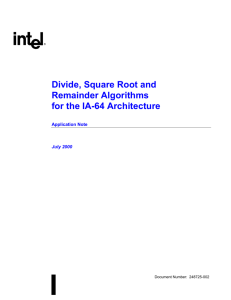SM_chapter32.pdf
advertisement
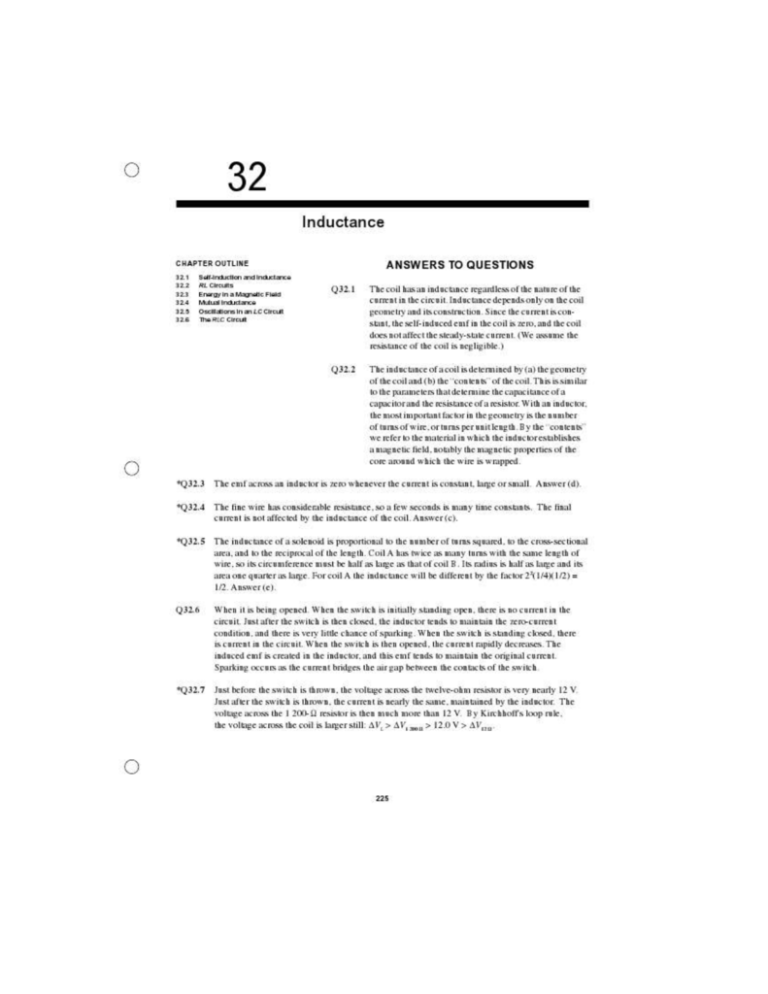
32 Inductance CHAPTER OUTLINE 32.1 Self-Induction and Inductance 32.2 RL Circuits 32.3 Energy in a Magnetic Field 32.4 Mutual Inductance 32.5 Oscillations in an LC Circuit 32.6 The RLC Circuit ANSWERS TO QUESTIONS Q32.1 The coil has an inductance regardless of the nature of the current in the circuit. Inductance depends only on the coil geometry and its construction. Since the current is constant, the self-induced emf in the coil is zero, and the coil does not affect the steady-state current. (We assume the resistance of the coil is negligible.) Q32.2 The inductance of a coil is determined by (a) the geometry of the coil and (b) the “contents” of the coil. This is similar to the parameters that determine the capacitance of a capacitor and the resistance of a resistor. With an inductor, the most important factor in the geometry is the number of turns of wire, or turns per unit length. By the “contents” we refer to the material in which the inductor establishes a magnetic field, notably the magnetic properties of the core around which the wire is wrapped. *Q32.3 The emf across an inductor is zero whenever the current is constant, large or small. Answer (d). *Q32.4 The fine wire has considerable resistance, so a few seconds is many time constants. The final current is not affected by the inductance of the coil. Answer (c). *Q32.5 The inductance of a solenoid is proportional to the number of turns squared, to the cross-sectional area, and to the reciprocal of the length. Coil A has twice as many turns with the same length of wire, so its circumference must be half as large as that of coil B. Its radius is half as large and its area one quarter as large. For coil A the inductance will be different by the factor 22(1/4)(1/2) = 1/2. Answer (e). Q32.6 When it is being opened. When the switch is initially standing open, there is no current in the circuit. Just after the switch is then closed, the inductor tends to maintain the zero-current condition, and there is very little chance of sparking. When the switch is standing closed, there is current in the circuit. When the switch is then opened, the current rapidly decreases. The induced emf is created in the inductor, and this emf tends to maintain the original current. Sparking occurs as the current bridges the air gap between the contacts of the switch. *Q32.7 Just before the switch is thrown, the voltage across the twelve-ohm resistor is very nearly 12 V. Just after the switch is thrown, the current is nearly the same, maintained by the inductor. The voltage across the 1 200-Ω resistor is then much more than 12 V. By Kirchhoff's loop rule, the voltage across the coil is larger still: ∆V L > ∆V 1 200 Ω > 12.0 V > ∆V 12 Ω . 225 226 Chapter 32 *Q32.8 (i) (a) The bulb glows brightly right away, and then more and more faintly as the capacitor charges up. (b) The bulb gradually gets brighter and brighter, changing rapidly at first and then more and more slowly. (c) The bulb gradually gets brighter and brighter. (d) The bulb glows brightly right away, and then more and more faintly as the inductor starts carrying more and more current. (ii) (a) The bulb goes out immediately. (b) The bulb glows for a moment as a spark jumps across the switch. (c) The bulb stays lit for a while, gradually getting fainter and fainter. (d) The bulb suddenly glows brightly. Then its brightness decreases to zero, changing rapidly at first and then more and more slowly. *Q32.9 The wire’s magnetic field goes in circles around it. We want this field to “shine” perpendicularly through the area of the coil. Answer (c). Q32.10 A physicist’s list of constituents of the universe in 1829 might include matter, light, heat, the stuff of stars, charge, momentum, and several other entries. Our list today might include the quarks, electrons, muons, tauons, and neutrinos of matter; gravitons of gravitational fields; photons of electric and magnetic fields; W and Z particles; gluons; energy; momentum; angular momentum; charge; baryon number; three different lepton numbers; upness; downness; strangeness; charm; topness; and bottomness. Alternatively, the relativistic interconvertibility of mass and energy, and of electric and magnetic fields, can be used to make the list look shorter. Some might think of the conserved quantities energy, momentum, ... bottomness as properties of matter, rather than as things with their own existence. The idea of a field is not due to Henry, but rather to Faraday, to whom Henry personally demonstrated self-induction. Still the thesis stated in the question has an important germ of truth. Henry precipitated a basic change if he did not cause it. The biggest difference between the two lists is that the 1829 list does not include fields and today’s list does. *Q32.11 The energy stored in the magnetic field of an inductor is proportional to the square of the current. Doubling I makes U = 12 LI 2 get four times larger. Answer (a). *Q32.12 Cutting the number of turns in half makes the inductance four times smaller. Doubling the current would by itself make the stored energy four times larger, to just compensate. Answer (b). Q32.13 The energy stored in a capacitor is proportional to the square of the electric field, and the energy stored in an induction coil is proportional to the square of the magnetic field. The capacitor’s energy is proportional to its capacitance, which depends on its geometry and the dielectric material inside. The coil’s energy is proportional to its inductance, which depends on its geometry and the core mate- rial. On the other hand, we can think of Henry’s discovery of self-inductance as fundamentally new. Before a certain school vacation at the Albany Academy about 1830, one could visualize the universe as consisting of only one thing, matter. All the forms of energy then known (kinetic, gravitational, elastic, internal, electrical) belonged to chunks of matter. But the energy that temporarily maintains a current in a coil after the battery is removed is not energy that belongs to any bit of matter. This energy is vastly larger than the kinetic energy of the drifting electrons in the wires. This energy belongs to the magnetic field around the coil. Beginning in 1830, Nature has forced us to admit that the universe consists of matter and also of fields, massless and invisible, known only by their effects. Inductance 227 *Q32.14 (a) The instant after the switch is closed, the situation is as shown in the circuit diagram of Figure (a). The requested quantities are: II R e 0 Q = 0 ∆V C I L =0+– ∆V L = I R = e 0 /R L=0 ,C=ε0, I R = ε R0 =0 ∆V R = e 0 ∆VL=ε 0,∆VC=0 , ∆ V R = ε 0 I C +e 0 – (b) After the switch has been closed a long time, the steady-state conditions shown in Figure (b) will exist. The currents and voltages are: III VVV = e 0 /R Figure (a) I L =0+– ∆V L =0 L=0,C=0, R = 0∆L=0,∆C=ε 0 ,∆ R = 0 I R =0Q=C e 0 ∆V C ∆V R =0 +– *Q32.15 (i) Answer (a). The mutual inductance of two loops in free space—that is, ignoring the use of cores—is a maximum if the loops are coaxial. In this way, the maximum flux of the primary loop will pass through the secondary loop, generating the largest possible emf given the changing magnetic field due to the first. (ii) Answer (c). The mutual inductance is a minimum if the magnetic field of the first coil lies in the plane of the second coil, producing no flux through the area the second coil encloses. Q32.16 When the capacitor is fully discharged, the current in the circuit is a maximum. The inductance of the coil is making the current continue to flow. At this time the magnetic field of the coil contains all the energy that was originally stored in the charged capacitor. The current has just finished discharging the capacitor and is proceeding to charge it up again with the opposite polarity. Q32.17 If R = e 0 e 0 Figure (b) FIG. Q32.14 4 C L , then the oscillator is overdamped—it will not oscillate. If R 4 C L , then the oscillator is underdamped and can go through several cycles of oscillation before the radiated signal falls below background noise. Q32.18 An object cannot exert a net force on itself. An object cannot create momentum out of nothing. A coil can induce an emf in itself. When it does so, the actual forces acting on charges in different parts of the loop add as vectors to zero. The term electromotive force does not refer to a force, but to a voltage. SOLUTIONS TO PROBLEMS Section 32.1 Self-Induction and Inductance P32.1 > < ε =− L ∆∆ It = −( 2 . 00 H ) −⎛ ⎝ 00. 500 0.010 0 A ⎞s ⎠ ⎛ 1 V⋅ s⎝ 1H ⋅ A ⎞⎠ = 100 V P32.2 Treating the telephone cord as a solenoid, we have: L ⎜ ⎟ =μ0 N2 Al = ( 4 π × 10 − 7 TmA ⋅ ) ( 70 . 0 ) 2 π (6. 50 × 10 − 3m) 2 0. 600 m =1. 36 μ H 228 Chapter 32 *P32.3 ε =− L dI dt =− d dt ( ω ) =− ω ω =− ( − )( π )( . ) cos ω t ε =−( 6 . 00 π ) cos ( 120 π t ) = −( 18 . 8 V ) cos ( 377 t ) P32.4 From L I max sin t L I max cos t .10 0 × 10 3 120 5 00 ε = L ⎛⎝ ∆ I∆ t ⎞⎠ , we have L = (∆Iε ∆ t ) = 24 . 0× 10 − 3 V 10.0 A s =2. 40 × 10 − 3 H From L ( 2 . 40 × 10 − 3 500 H) (4. 00 A ) =. μ T ⋅ m2 P32.5 L = N ΦI B , we have Φ B = LI N = 19 2 =μ0 N2 Al = μ 0 ( 420 ) 2 ( 3 . 00 × 0 . 160 10 − 4 ) = 4 . 16 × 10 − 4 H ε =− L dI dt → dI dt = − Lε = − 4.16 175 × × 10 10 − − 46HV =− 0 .421 A s P32.6 ε =L dI dt = ( 90 . 0 × 10 − 3 ) dt d (t2− 6t) V (a) At t =1 00. s, ε = 360 mV (b) At t = 4 00. s, ε = 180 mV (c) ε = ( 90 . 0 × 10 − 3 ) ( 2 t − 6 ) = 0 when t = 3 00. s P32.7 (a) B = μ 0 nI = μ0 ⎛ 450 ⎝ 0. 120 ⎞⎠ ( 0 . 040 0 A ) = 188 μ T (b) Φ B = BA = 3 . 33 × 10 − 8 T ⋅ m2 (c) L =N ΦI B= 0 375. mH (d) B and Φ B are proportional to current; L is independent of current. P32.8 L Φμ π μ π 2 22 P32.9 =N I B = NBA I ≈ NA I ⋅ 0 NI R = 0 NAR ε=ε 0 e− kt =− L dI dt dI =− ε L 0 e − kt dt If we require I → 0 as t →∞, the solution is I ε 0 kL Q Idt kL =e − kt = dq dt = ∫ = ∫ ∞ε ε 020 0 e− kt dt =− kε2 0L Q = kL FIG. P32.8 Inductance 229 Section 32.2 RL Circuits P32.10 Taking τ = RL dI ⎛ 1 ⎞ dt ⎝ ⎠ IR L ,I=Ii e − t τ: =Ii e −tτ ⎜ − τ ⎟ + dI dt = 0 will be true if IRe i 1 0 Because τ = −t τ+ L ( Ie i −tτ ) ⎛⎝ − τ ⎞⎠=LR , we have agreement with 0 = 0 . P32.11 (a) At time t, I ( t )= ε (1 − e − t R τ) where τ = = I (A) I max LR 0 200. s FIG. P32.11 0 1 After a long time, I ε(1 ) = ε 0.5 0 0 0.2 0.4 0.6 At I ( t ) = 0 500. I max max = − e −∞ R R t (s) (0. 500 )εR = ε (1− e−tR 0. 200 s ) so 0 . 500 = 1 − −e t 0 . 200 s Isolating the constants on the right, ln ( e t− 0 . 200 s ) = ln ( 0 . 500 ) and solving for t, − 0 . 200 t s =− 0. 693 or t = 0 139. s (b) Similarly, to reach 90% of I max , 0 . 900 = 1 − −e t τ and t = − τ ln ( .1 − 0 900 ) Thus, t = −( 0 . 200 s ) ln ( 0 . 100 ) = 0 . 461 s *P32.12 The current increases from 0 to asymptotically approach 500 mA. In case (a) the current jumps up essentially instantaneously. In case (b) it increases with a longer time constant, and in case (c) the increase is still slower. I 500 mA (a) (b) (c) 0 FIG. P32.12 t 230 Chapter 32 P32.13 (a) τ = L R = 2 . 00 × 10 − 3 .s = 2 00 ms (b) I = I max (1 − e−tτ ) = ⎛⎝ 6. 00 4.00 V ⎞Ω ⎠ (1−e− 0 . 250 2 . 00) = 0 . 176 A (c) I max =ε R=6. 00 V 4.00 Ω = 1 . 50 A (d) 0 . 800 = 1 − −e t 2 . 00 ms → t =−( 2 . 00 ms ) ln ( 0 . 200 ) = 3 . 22 ms P32.14 I R FIG. P32.13 =ε (1 − e−tτ) = 120 9 . 00 (1− e− 1 . 80 7 . 00 ) = 3 . 02 A ∆ VR = IR =( 3 . 02 )( 9 . 00 ) = 27 . 2 V∆VL=ε −∆ V R = 120 − 27 . 2 = 92 . 8 V P32.15 (a) ∆ V R = IR =( 8 . 00 Ω )( 2 . 00 A ) = 16 . 0 V and ∆ V L ε ∆V R 36 . 0 V 16 . 0 V 20 . 0 V Therefore, continued on next page =−=−= ∆ V R∆ V L = 16 20.0 . 0 VV = 0. 800 (b) ∆ V R = IR =( 4 . 50 A )( 8 . 00 Ω ) = 36 . 0 V ∆ V L = ε −∆V R = 0 P32.16 After a long time, 12 . 0 V = ( 0 . 200 A )R . Thus, R = 60 0. Ω. Now, τ = gives L = τ R = ( 5 . 00 × 10 − 4 s )( 60 . 0 V A ) = 30 . 0 mH P32.17 I = I − et1 τ=== max (1− τ ) : dI dt =− I max (e− tτ ) ⎛⎝ − τ ⎞⎠ L εR 15 . 0 H 30.0 Ω 0. 500 s: dI dt =RL I max e− t τ and I max = R (a) t = 0: dI dt =RL I max e 0 =εL = 15.0 100 VH = 6 . 67 As (b) t =1 50. s: ε τ 6 . 67 A s 1 . 50 0 . 500 6 . 67 A s) −e 3 . 00 = 0 . 332 A s P32.18 Name the currents as shown. By Kirchhoff’s laws: I1I2I 3 dI dt = L e − t =( ) e − ( ) =( = + (1) + 10 . 0 V − 4 . 00 I 1 − 4 . 00 I 2 =0 (2) + 10 . 0 V − 4 . 00 I 1 − 8 . 00 I 3 −( 1 . 00 ) dI dt 3=0 (3) LR FIG. P32.18 FIG. P32.15 Inductance 231 From (1) and (2), + 10 . 0 − 4 . 00 I 1 − 4 . 00 I 1 + 4 . 00 I 3 =0 and I 1 = 0 . 500 I 3 + 1 . 25 A Then (3) becomes 10 . 0 V − 4 . 00 ( 0 . 500 I 3 + 1 . 25 A ) − 8 . 00 I 3 −( 1 . 00 ) dI dt 3= 0 ( 1 . 00 H ) ⎛⎝ dI 3 ⎞ dt ⎠ +( 10 . 0 Ω )I3 = 5 . 00 V We solve the differential equation using equations from the chapter text: I3 (t)= ⎛⎝ 10.0 5 . 00 ΩV ⎞⎟⎠ ⎡ ⎣ 1 − e −( 10 . 0 Ω ) t 1. 00 H ⎤ ⎦ = ( 0 500 ) ⎡ ⎣ 1 −−⎤ ⎦ = 1 25 + 0 500 = . .. AesII 10 13 t 1 . 50 A −( 0 . 250 A ) −e 10 t s P32.19 (a) Using τ = RC =⎜ RL , we get R =CL = 3. 00 H 3.00 × 10 − 6 F = 1 . 00 × 10 3 Ω= 1 . 00 kΩ . (b) τ = RC = ( 100 . × 10 3 Ω ) ( 300 . × 10 − 6 .F ) = 300 × 10 − 3 s = 3 00. ms P32.20 For t ≤ 0, the current in the inductor is zero . At t = 0, it starts to grow from zero toward 10.0 A with time constant τ=LR = ( 10 . 0 ( 100 mH )Ω ) =1. 00 × 10 − 4 s For 0 ≤ t ≤ 200 μs, I = I max (1− e−tτ) = ( 10 . 0 A ) ( 1 − e− 10 000 t s ) . At t = 200 μ s, I =( 10 . 00 A ) ( 1 − e − 2 . 00 ) = 8 . 65 A. Thereafter, it decays exponentially as I = I i e −′τ, t so for t ≥ 200 μ s, I =( 8 . 65 A ) e − 10 000 ( t − 200 μ s ) s =( 8 . 65 A ) e − 10 00 0 t s + 2 . 00 = ( 8 . 65 e 2 . 00 A ) e − 10 000 t s = ( 63 . 9 A ) e − 10 000t s P32.21 τ = L R =0. 140 4 . 90 = 28 . 6 ms I max =εR =6. 00 V 4.90 Ω = 1 . 22 A (a) I = I max (1− e− tτ) so 0 . 220 = 1 . 22 ( 1 − −e t τ ) e t− τ = 0 820. : t = − τ ln ( 0 . 820 ) = 5 . 66 ms (b) I = I max (1− e − 10 . 0 0 . 028 6 ) =( 1 . 22 A ) ( 1 − e− 350 ) = 1 . 22 A (c) I = I max e− t τ and 0 . 160 = 1 . 22 −e t τ so t = − τ ln ( 0 . 131 ) = 58 . 1 ms FIG. P32.20 FIG. P32.21 232 Chapter 32 P32.22 (a) For a series connection, both inductors carry equal currents at every instant, so same for both. The voltage across the pair is dI dt is the L eq dI dt dI dI dt dt = 1 + 2 (b) L =L 1+ L 2 so L eq LL dI eq dt =L 1 dI dt =L dI 2 dt = ∆V L where I = I 1 + I2 and dI dt = dI 1 dt + dI dt 2 Thus, 1 2 ∆V ∆V ∆VL L L 1=1+ 1 12 (c) L eq L=1L+ 2 L and L eq LL dI eq dt + R eq I=L 1 dI dt + IR 1 + L 2 dI dt + IR 2 Now I and dI dt are separate quantities under our control, so functional equality requires both L eq L L R eq RR . (d) ∆V L = 1 + 2 and = 1 + 2 = dI eq dt + R eq I = L 1 dI 1 dt +R1I1=L 2 dI 2 dt + R2I2 where I = I 1 + I2 and dI dt = dI 1 dt + dI 2 dt . We may choose to keep the currents constant in time. Then, 1=1+ 1 12 We may choose to make the current swing through 0. Then, R eq RR 1=1+ 1 12 This equivalent coil with resistance will be equivalent to the pair of real inductors for all other currents as well. Section 32.3 Energy in a Magnetic Field P32.23 L L eq LL =μ0 l ( 68 0 ) 2 ⎡ ⎣ ( 0 600 × 10 ) ⎤ 0 080 0 2 N 2 A = μ 0 .π . . − 2 ⎦ = 8 21. Hμ U=12 LI = 1 2 (.× − H )( . A ) 2 = . Jμ P32.24 (a) The magnetic energy density is given by u 2 8 21 10 6 0 770 2 44 = B 2 2 μ 0 = 2(1. 26 ( × 4 . 10 50 − 6T TmA ) 2 ⋅ ) =8. 06 × 10 6 J m3 (b) The magnetic energy stored in the field equals u times the volume of the solenoid (the volume in which B is non-zero). U = uV = ( . × Jm3)⎡ ⎣ (.m)π(.m)2 ⎤ ⎦ = 6 32. kJ P32.25 u 8 06 10 6 0 260 0 031 0 = ∈ 0 E 2 2 = =B 2 = 0 44 2. nJ m3 u 2 μ 995 μ J m3 Inductance 233 ∞ P32.26 ∫ e − 2 Rt L dt ∞ − 0 =− L R ∫ −⎛ 2 Rdt ⎞ L⎝ L ⎠ 2 R L R (L LR R *P32.27 (a) P = I∆V = 3A 22 V = 66.0 W (b) P = I∆V R 2 0 e 2 Rt L ⎜ ⎟=− e − 2 Rt L ∞ 0 =− 2 e −∞ − e 0 ) =2 (0−1 )=2 = I2R = (3A)2 5 Ω = 45.0 W (c) When the current is 3.00 A, Kirchhoff’s loop rule reads + 22 . 0 V −( 3 . 00 A )( 5 . 00 Ω )− ∆V L = 0 . Then ∆V L = 7 00. V The power being stored in the inductor is I∆V L =( 3 . 00 A )( 7 . 00 V ) = 21 . 0 W (d) At all instants after the connection is made, the battery power is equal to the sum of the power delivered to the resistor and the power delivered to the magnetic field. Just after t = 0 the resistor power is nearly zero, and the battery power is nearly all going into the magnetic field. Long after the connection is made, the magnetic field is absorbing no more power and the battery power is going into the resistor. P32.28 From the equation derived in the text, (a) The maximum current, after a long time t, is I I =εεR R (1 − e− Rt L ) 2 00. A At that time, the inductor is fully energized and P = I ( V∆ ) = ( 2 . 00 A )( 10 . 0 V ) = 20 . 0 W . (b) P lost == = I 2 R =( 2 . 00 A ) 2 ( 5 . 00 Ω ) = 20 . 0 W (c) P inductor I ( V∆ drop ) =0 (d) U = = LI 2 2 = ( 10 . 0 H )( 2 . 00 A ) 2 2 = 20 . 0 J P32.29 The total magnetic energy is the volume integral of the energy density, u = B 2 . 0 Because B changes with position, u is not constant. For B B 2μ = ⎛ R⎝ r ⎞⎟⎠ 2 ,u = ⎛ ⎝ 2Bμ02 0 ⎞ ⎠ ⎛⎝ Rr ⎞⎠ 4 . Next, we set up an expression for the magnetic energy in a spherical shell of radius r and thickness dr. Such a shell has a volume 4 πr 2 dr, so the energy stored in it is dU u r dr 0 ⎜ ⎜ ⎟ ⎜ ⎟ ⎛⎝ π 24 ⎞μ 0 ⎠ We integrate this expression for r = R to r =∞ to obtain the total magnetic energy outside the sphere. This gives U = (4 π 2) = ⎜ 2 B0 R dr ⎟ r 2 =2π B0 2R 3 μ 0 (= 2 π 500 . × 10 − 1 . 5 T) 2 ( 600 . ( 26 × 10 −6 TmA ⋅ × 10 ) 6 m ) 3 =2. 70 × 10 18 J FIG. P32.27 234 Chapter 32 Section 32.4 Mutual Inductance P32.30 I 1 ( t ) = I max e− αt sin ω t with I max = 5 . 00 A, α = 0 . 025 0 sJ 1 , and ω = 377 rad s dI 1 dt = I max e− α t ( − α sin ω t + ω cos ω t ) At t = 0 800. s, dI 1 dt =( 5 . 00 A s ) e − 0 . 020 0 ⎡ ⎣ −( 0 . 025 0 ) sin ( 0 . 800 ( 377 ) ) + 377 cos ( 0 . 800 ( 377 ) ) ⎤ ⎦ Thus, ε 2 = − dI dt dI 1 dt = = 1 . 85 × 10 3 A s − ε = 1.85 + 3 × . 10 20 3 V As 1 . 73 mH P32.31 M 1: M 2 dI 1 dt = ε 2 =− M dI 1 dt =− ( 100 . × 10 − 4 H ) ( 100 . × 10 4 A s ) cos ( 100 0t ) (ε 2 ) max = 1 . 00 V P32.32 Assume the long wire carries current I. Then the magnitude of the magnetic field it generates at distance x from the wire is B μ π Ix , and this field passes perpendicularly through the plane of the loop. The flux through the loop is Φ B = 2 0 μ π 1.70 ∫ mm = μ π .. The mutual inductance between the wire and the loop is then M =∫B⋅ dA = ∫ BdA = ∫ B ( l dx )= 0 Il dx 2 0 . 400 mm x 20 Il ln ⎛⎝ 0 1 400 70 ⎞⎠ =N 2ΦI1 ( ( − TmA ) × −m ) () M = 7 . 81 × 10 − 10 H = 781 pH P32.33 (a) M 12 = N2 2μπ 0II l ln ⎛⎜⎝ 01.. 400 70 ⎞ ⎟= ⎠ N 22μπ0 l (1. 45 )= 14π × 10 7 ⋅ 2 π 270 . 10 3 1 . 45 =N BΦIA BA = 700 ( 900 . × 10 − 6)3. 50 = 18 . 0 mH (b) L A Φ I 400 ( 300 × 10 − 6 )3. 50 = . mH (c) =A = 34 3 Aε B =− M dI dt A =−( 18 . 0 mH )( 0 . 500 A/s ) = − 9 . 00 mV P32.34 (a) Solenoid 1 creates nearly uniform field everywhere inside The The The flux though one turn emf induced in solenoid mutual inductance is of m solenoid 0 2 p is R 2 2N –(m 1 N22 is /l 0 pR m 2 0 2N p 1 R N2 2 2N /l)(dI/dt) 1 I/l it, given by m 0 N 1 I/l (b) Solenoid 2 creates nearly uniform field everywhere inside it, given by and nearly zero field outside. m 0 I/l The flux though one turn of solenoid 1 is m 0 N 2 The emf induced in solenoid The mutual inductance is m 0 1 p is R 2 2N –(m 1 N 20 /l p R 2 2N p 1 NR 2 2 /l)(dI/dt) 2N 2 I/l (c) The mutual inductances are the same. This is one example of von Neumann’s rule, mentioned in the next problem.
